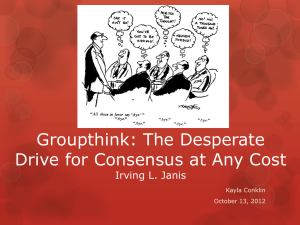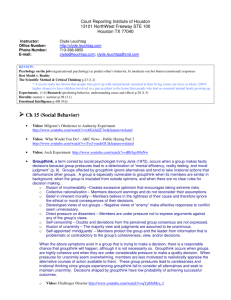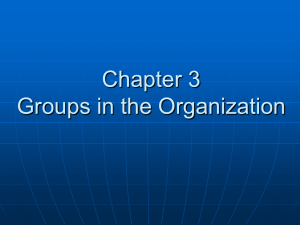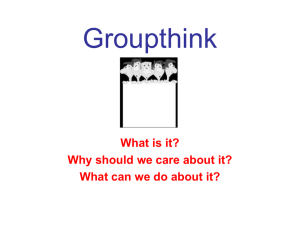Groupthink, Bay of Pigs, and Watergate Reconsidered
advertisement
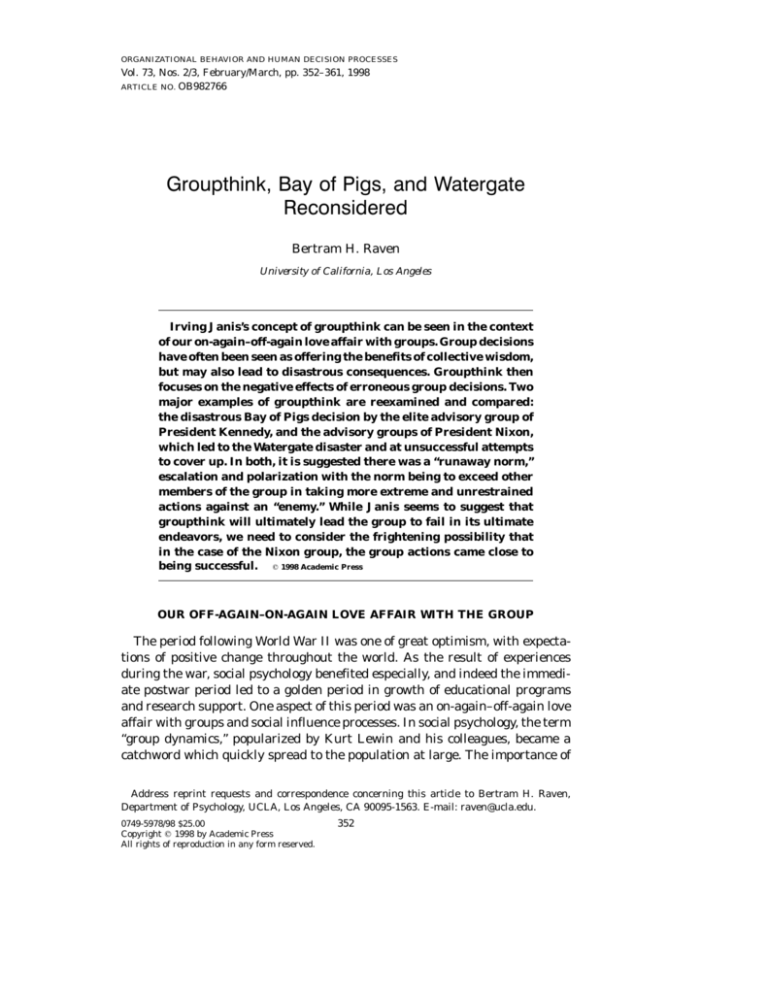
ORGANIZATIONAL BEHAVIOR AND HUMAN DECISION PROCESSES Vol. 73, Nos. 2/3, February/March, pp. 352–361, 1998 ARTICLE NO. OB982766 Groupthink, Bay of Pigs, and Watergate Reconsidered Bertram H. Raven University of California, Los Angeles Irving Janis’s concept of groupthink can be seen in the context of our on-again–off-again love affair with groups. Group decisions have often been seen as offering the benefits of collective wisdom, but may also lead to disastrous consequences. Groupthink then focuses on the negative effects of erroneous group decisions. Two major examples of groupthink are reexamined and compared: the disastrous Bay of Pigs decision by the elite advisory group of President Kennedy, and the advisory groups of President Nixon, which led to the Watergate disaster and at unsuccessful attempts to cover up. In both, it is suggested there was a “runaway norm,” escalation and polarization with the norm being to exceed other members of the group in taking more extreme and unrestrained actions against an “enemy.” While Janis seems to suggest that groupthink will ultimately lead the group to fail in its ultimate endeavors, we need to consider the frightening possibility that in the case of the Nixon group, the group actions came close to being successful. q 1998 Academic Press OUR OFF-AGAIN–ON-AGAIN LOVE AFFAIR WITH THE GROUP The period following World War II was one of great optimism, with expectations of positive change throughout the world. As the result of experiences during the war, social psychology benefited especially, and indeed the immediate postwar period led to a golden period in growth of educational programs and research support. One aspect of this period was an on-again–off-again love affair with groups and social influence processes. In social psychology, the term “group dynamics,” popularized by Kurt Lewin and his colleagues, became a catchword which quickly spread to the population at large. The importance of Address reprint requests and correspondence concerning this article to Bertram H. Raven, Department of Psychology, UCLA, Los Angeles, CA 90095-1563. E-mail: raven@ucla.edu. 0749-5978/98 $25.00 Copyright q 1998 by Academic Press All rights of reproduction in any form reserved. 352 GROUPTHINK RECONSIDERED 353 group cooperation and group decisions in productivity and effective problemsolving became an important topic of study and application (Lewin, 1947, 1952). In order to implement change in working conditions, group discussion and participation was demonstrated in theory, research, and application (Coch & French, 1948). However yet, at the same time, we saw others who questioned and even ridiculed the emphasis on groups and committees. The group discussion and group decision studies, which showed how group norms could contribute to greater productivity, were attacked as simply one more manipulative device whereby management could get workers to work harder and longer without an increase in pay (Gunderson, 1950). Groups and committees were often seen as wasteful of time and often resulting in inferior products. C. Northcote Parkinson (1957), with his clever tongue-in-cheek style, illustrated how decisions by groups and committees effectively operated at their lowest common denominator.1 The controversy continues even to this day. Moscovici (1976) and his colleagues seem to see the group majority as stifling correct creative solutions by the minority member, pointing out how a heroic minority member can (and probably should) overcome the tyranny of the majority though forceful independence. Paicheler (1988), following this same line, argues that the entire emphasis on group decisions and conformity can be seen as a kind of cultural conspiracy to maintain the status quo against social change. By now the resolution parallels those which follow most such debates: groups can be effective and can have much to contribute in terms of effective decisionmaking, greater productivity, higher morale, etc. However, they can also lead to negative and wasteful results, and they can also be manipulated by those who wish to use them for their own purposes. The practical issue boils down to how we can benefit from their positive contributions while minimizing the negative. That would seem to be the very issue that Janis examined in his analysis of what he called groupthink. THE POWER OF THE ERRONEOUS MAJORITY I have often thought that the paradigm for what Janis later called the groupthink phenomenon can be seen in a generally forgotten, simple experiment conducted by Norman Maier and Allen Solem (1952). They presented their subjects with a simple problem: “A man bought a horse for $60 and sold it for $70. Then he bought it back for $80 and sold it again for $90. How much money did he make or lose in the horse business?” Subjects, when asked individually, gave a variety of answers: losing $10, breaking even, or making $10, $20, or $30.2 When the problem was presented to discussion groups of 1 I don’t know how many times I have heard a speaker, searching for a humorous introduction, begin his/her presentation by saying that a camel was a horse designed by a committee. I always laugh dutifully, along with the others, but later think, “Wait a minute. Considering the terrain in which it operates, a camel is actually a quite well-designed horse.” 2 Of course, the correct answer is $20 profit—the man laid out a total of $140 and received a total of $160. It is always surprising the number of intelligent subjects who don’t come out with the correct answer. 354 BERTRAM H. RAVEN five or six, and a unanimous decision was required, the number of correct answers rose somewhat, in comparison with the individual judgments. (Chalk one up for the pro-group side?) However, this happened only when the majority started out with a correct answer—if the majority held an incorrect answer, then there was an even greater likelihood of group errors. (Anti-group?) However, the number of correct answers increased substantially even in those latter groups, if there was a group leader who encouraged the expression of minority opinions! In a later study, it was found that groups that reached a unanimous decision were more satisfied than those which did not reach a unanimous decision—and this was true even when the unanimous decision was incorrect! (Thomas & Fink, 1961). Despite our ambivalence toward groups, everyday wisdom would argue that it is obvious that in solving complex problems which require a broad range of information, a decision by several people would be superior to a decision by a single person. If “two heads are better than one,” what about six, seven, or eight heads? Further, suppose that the group is composed of very intelligent and knowledgeable people; their collective wisdom should be all the better. How then could one account for John F. Kennedy’s presidential advisory group, composed of the “best and the brightest” (Halberstam, 1972), developing and approving plans for the Bay of Pigs invasion of Cuba, frequently characterized as one of the most militarily disastrous and morally disgraceful ventures in American history. There were many who were bothered by this question, including leading members of the Kennedy team, and even President Kennedy himself. THE ROOTS OF GROUPTHINK Irving Janis also thought about this curious phenomenon and suggested it to his daughter, Charlotte, who was looking for a interesting topic for her high school history term paper. As he reviewed her research, Janis became increasingly obsessed and felt compelled to find some answers. For his explanations, he drew on tools with which he was familiar, he reviewed especially the vast literature of theories and research on group behavior. His initial search might have shown all sorts of theories and empirical evidence which would have predicted what general wisdom would have suggested. After all, there is plenty of evidence that groups perform better if they have high morale, high cohesiveness, good leadership, high intelligence, excellent knowledge and experience, etc. Then, he also noted how factors which might ordinarily lead to greater effectiveness could also in some circumstances lead to less effective and even disastrous results. He did, in fact, note the very high morale and cohesiveness in the Kennedy team, as the Democrats took control of the presidency after 8 years out of office. But he also was aware of studies which indicated that groups tend to conform to a common norm when cohesiveness and morale are high. In such cases, pressures on the deviant members of the group can be tremendous. When the majority is wrong, that can obviously have very deleterious effects. He would have been aware of findings, such as those GROUPTHINK RECONSIDERED 355 reported by Muzafer Sherif et al. in the Robber’s Cave study (Sherif, Harvey, White, Hood, & Sherif, 1961), which showed how a high level of morale could lead to a sense of superiority toward the outgroup. The effects of group norms on polarization and adoption of extreme, often maladaptive, decisions had been demonstrated in various studies, including the research on group polarization and the “risky shift” (e.g., Kogan & Wallach, 1967; Stoner, 1961; Teger & Pruitt, 1967). There is even evidence that group polarization will lead groups to take more extreme positions in evaluating outgroups (Moscovici & Zavalloni, 1969). Janis did not document most of these studies in either edition of Groupthink (1972, 1982) [he does not even mention Maier and Solem (1952)], but we can assume that he was aware of the basic findings. Further documentation is provided in the very thorough review by Hart (1990) and by Esser (1998), Hart (1998), and McCauley (1998) this issue. THE IMPORTANCE OF GROUP COHESIVENESS In their article in this issue, Sally Fuller and Ramon Aldag (1998) boldly assume the role of devil’s advocate in criticizing the groupthink analysis offered by Janis. How, they ask, can Janis say that high cohesiveness is the “critical trigger in the groupthink phenomenon” when the “benefits of group cohesion have long been recognized”? They rely on such arguments to say that Janis’s theory is inherently inconsistent and empirically not supported. Perhaps the analogy might be the benefits of various forms of fertilizer, which have contributed to human benefit by leading to bumper crops and better life for plants, animals, and humans. When combined in certain combinations, with other elements, they become the destructive force which can destroy all living things, as in the Oklahoma bombing. We can all think of things which are generally beneficial, but which in certain circumstances and in certain combinations can become very destructive. So it is with group cohesiveness. The real genius, then, lies in determining what these circumstances and combinations might be which would lead to deleterious effects. Once one knows this, then recommendations can be made as to how effective leadership might operate to allow for the beneficial effects of group cohesiveness while safeguarding against the its stultifying effects in inhibiting expression of minority opinion and against the unrealistic positive evaluation of one’s own group and the negative evaluation of opposing groups. GROUPTHINK IN WATERGATE AND ITS COVER-UP Just as Janis became infatuated with the mystery of the Bay of Pigs decision making process, several years later, like many of us, I found myself taken by the advisory groups associated with President Nixon, who were involved in the planning activities which resulted in the Watergate fiasco and the coverup afterward. The Nixon advisory group was also composed of very intelligent and knowledgeable men (yes, again, they were all men). The phenomena which 356 BERTRAM H. RAVEN eventually led to the collapse of the Nixon administration were, of course, quite different from those which led to the disaster at the Bay of Pigs. First of all, the “enemy” was different. The Kennedy group had to deal with an external enemy, with Fidel Castro and the government of Cuba. The Nixon group had to deal with a domestic “enemy,” the so-called liberal establishment and more specifically the Democratic party. Also, the activities of the Nixon people actually involved two sets of actions: (a) What have been called the “White House horrors,” wherein the executive offices were involved, directly and indirectly, in secret surveillance of opponents, use of the Internal Revenue Service and various governmental agencies to punish the “enemies,” and use of burglaries to gain destructive information (including the burglary of the offices of the psychiatrist to scientist and peace activist Daniel Ellsburg, and the final bungling burglary of the Democratic Party Headquarters in the Watergate building) and (b) the cover-up activities after the discovery of the White House horrors. There were different planning and advisory groups involved in these two decision-making processes. I watched many hours of hearings on television, read many transcripts and reports, and then drew on what I knew from the literature from social psychology and group dynamics. Much of what I read, then, led me to find Janis’s groupthink theory helpful in my analysis—though I cited a number of other theories as well (Raven, 1974). I, of course, felt highly complimented when the second edition of groupthink was published and I found that Janis found my analysis helpful in his updating his analysis of groupthink (Janis, 1982). WAS THE “NIXON GROUP” COHESIVE? Janis had emphasized the importance of group cohesiveness to the groupthink process. Did high cohesiveness characterize the Nixon group? Not if you think of cohesiveness in terms of the members of the group being having strong positive feelings toward one another. In fact, there is evidence that a number of members of the group strongly disliked and were in active competition with one another. However, group cohesiveness is defined in terms of the resultant forces on individual members to continue their membership in and identification with the group. Back (1951) pointed out that factors other than interpersonal attraction can affect cohesiveness, a point also made by McCauley (1998) in his article in this issue. Among the other factors are attraction to the group goal, the prestige and other qualities of membership in the group itself, and attraction toward and dependence upon the leader of the group. What can attract one to a group more than the perception that this group is successful, coupled with the belief that by maintaining significant membership in that group one’s own future can be assured? These seemed quite evident in the Nixon group. Certainly after the successful defeat of the Democrats in the 1972 election, they could sense that belonging to that group and association with Nixon and his administration would lead to their personal advancement both politically and otherwise. GROUPTHINK RECONSIDERED 357 INTRAGROUP COMPETITION AND THE “RUNAWAY NORM” It was this form of “cohesiveness” and its effects in the Nixon group which I found particularly intriguing. The many illusions which Janis had described in his analysis of the Kennedy advisory group were very much present: the sense of invulnerability and superiority (buttressed by prior success), the suppression of personal doubt, conformity to basic norms reinforced by suave leadership. . . However, there was the additional factor which I called a “runaway norm.”3 The concept is similar to the notion of group polarization. Though we usually think of group norms as operating to lead to pressure to conform to the norm, there are situations in which simply conforming to the norm is not sufficient. In order to maintain one’s position in the group, or improve it, one must attempt to exceed the norm. As the members each try to exceed the norm, the norm itself rises, leading to escalation of behavior in the group. This is one explanation which had been offered for the “risky shift” phenomenon—it is sometimes highly desirable to try to be a bit more risky than other group members. In the Nixon group, the norm was to be more aggressive, less inhibited by the usual moral restraints, in taking action against the “enemy,” especially as represented in the Democratic party and liberal thinkers. The model for such behavior was the president himself who was known to have successfully utilized unrestrained aggressive techniques throughout his political career.4 However, in the Nixon group, there two subgroups, characterized by Theodore White (1973) as “the big team” and “the young team.”5 The individuals in each team were pressed to be more extreme than each of their members, but this was further amplified by pressures on each team to try to exceed the other in aggressiveness. POLITICAL AND OTHER CONSIDERATIONS IN GROUPTHINK In this issue and elsewhere there have been discussions of many examples which are relevant to the groupthink theory. In some of these, it appears that 3 The concept of “runaway norm” is not original with me. However, I forget who I got it from and therefore regret that I cannot give due credit. The physical analogy would be a thermostat in which someone had altered the element so that as the temperature increased, the thermostat is programmed not to reduce the temperature but to increase it. 4 Richard Nixon, over his political career, despite a few setbacks, appears to have been remarkably successful in using strong, and sometimes Macchiavellian methods, to defeat his political opponents, going back to his early defeat of Congressman Jerry Voorhis, in his first congressional campaign, and popular Senator Helen Gahagan Douglas a few years later. [See, for example, Brodie (1981), Mazo & Hess (1968), and Wills (1971).] For ambitious politicians who had been recruited to his advisory groups, he would serve as a powerful referent and expert power in affecting their behavior and also the norms of the groups of which they were a part. 5 I was, of course, pleased that Janis (1982) was able to include my analysis in his expansion of his groupthink review in the second edition. In my analysis, I tried to represent the membership of these two competitive teams in diagrams indicating the positive and negative relationships among the members. Janis (1982) takes some issue with exactly who was a member of each team. My representation was based on my reading of White (1973), which, in turn, were his observations of the membership during the 1972 election campaign. Quite possibly there was a change by the time of the meetings on the cover-up following the bungled Watergate burglary. In any case, I would stick by my representation of the essential process. 358 BERTRAM H. RAVEN the basic features of Janis’s theory apply; others do not fit the theory so neatly. It is important for us to keep in mind that in neither of his two books on groupthink did Janis take the position that groupthink was the only factor which accounted for the failures of the group decisions which he describes. In that sense, then, I believe that it is reasonable to assume that Janis would not have had any uneasiness in accepting Rod Kramer’s (1998) position that political considerations would enter into the process as well, as indeed they often have. In my discussion here, I have been focusing on the two examples of group decision processes which appear to have gone awry: the Bay of Pigs Fiasco and Watergate and the related cover-up attempts. Obviously, the two examples are quite different in many ways, and I have pointed out some ways in which they differ. In both cases, there were, in fact, political considerations, but these were especially clear, I think, in the Nixon group. The entire process, including the disastrous burglary, was guided by political motivations. The additional difference, as we have noted above, is that Richard Nixon himself loomed large in that entire process. His referent power, furthered by his immense success through lack of usual restraints, was especially powerful. His reward and coercive power were also very salient. To a considerable extent, the competition in the group, the runaway norm, can be seen in terms of who could best emulate him and his immediate followers in giving no quarter to political opponents. Does Groupthink Necessarily Lead to Failure? Groupthink, as it is generally defined, suggests a fiasco, a failure of the group in its basic mission. Reviewing recent new information, particularly as revealed recently in Nixon’s White House tapes, suggests that “failure” in its mission need not be a necessary part of the definition of groupthink. While there seems to be a clear deterioration of moral judgment, and a move to extreme uninhibited action in the Nixon group, I think we might recognize the frightening thought that in fact the Nixon team came remarkably close to being successful! The array of weapons which Nixon and his team had developed in dealing with uncooperative liberal Democrats and Republicans, news media, government officials, including the Secret Service, the FBI, the IRS, and other governmental and nongovernmental agencies (burglars, eavesdroppers, spies, etc.), is truly staggering. Did these fail because of the natural deteriorating process of groupthink? Not really. One might contemplate what could have developed were it not for (a) some bungling burglars breaking in to Democratic Party Headquarters at the wrong time and leaving some suspicious scotch tape to keep a door unlocked; (b) some observant guards and custodians at the Watergate building who happened to notice lights on at the wrong place at the wrong time and then noting the suspicious tape; (c) Nixon’s confidently taping conversations in the Oval Office, and later being reluctant to destroy these tapes. Both Carl Bernstein (1997) and Alexander Haig (1997), as well as others, discussing the Watergate phenomenon on its anniversary, and with the new information recently revealed, have expressed alarm at how close we came to GROUPTHINK RECONSIDERED 359 a virtual police state. So we must consider that many of the elements of groupthink which lead to reduction of restraints against extreme measures, and suspension of moral values, might indeed lead to success, but with frightening consequences. It is likely that we can find examples in which such unfortunate outcomes have occurred. Some of the safeguards which Janis suggested might help to avoid such outcomes, but it is likely that even more are needed. GROUPTHINK: A GENERAL ASSESSMENT The article by Fuller and Aldag (1998) is quite clever and entertaining. However, in my opinion, they got carried away by their adopted role as devil’s advocate. Even if most of us can identify some flaws in the groupthink analysis, we would still give Janis a lot of credit for his careful and scholarly analysis, his relating a broad body of literature on group processes and group dynamics to the understanding of a series of very significant social-political events. Most of the articles in this issue have taken issue with some of his applications and some of his interpretations of the social psychological literature. However, it is bordering on the absurd to see groupthink as in the same category with collective imaginative nonsense such as the foul-smelling “el chupacabras” (goatsucker) or the mythical tale of Tonypandy. There are, of course, many other similar phenomena which they could also have cited. Why not the Abominable Snowman, Sasquatch, the Lochness monster, or visiting aliens in their UFOs? Yes, we can accept their point that myths and folk tales will often develop in a community or society. However, can they really believe that that applies to groupthink and to its widespread acceptance? No social scientific theory is perfect, but there is no need to so demean Janis’s theories, the care with which he examined the evidence and tried to make sense out of it, his application of a wide range of careful research on group dynamics and social psychology, or the intelligence of the many competent scholars who find them convincing. Janis goes on to apply the groupthink model not only to the Bay of Pigs fiasco, and Watergate, but also group decisions relating to the Korean War, lack of proper defense of Pearl Harbor, escalation of the Vietnam War, and the more effective decision in the Cuban Missile Crisis. There have been several applications by others (several of which are discussed in this issue): (a) the Space Challenger disaster (Esser, 1998; Moorhead, Ference, & Neck, 1991), (b) the decision by the Japanese advisory group to bomb Pearl Harbor (Whyte, 1998), (c) decision-making in self-managing work teams, and top-management teams (Moorhead, Neck, & West, 1998; Peterson, Owens, Tetlock, Fan, & Martorana, 1998). In practically all of these applications, the authors have found some points in which the phenomenon they studied did not fit Janis’s groupthink formulation exactly. Often, these investigators have focused on an additional factor which needed to be considered, which fit that particular investigator’s line of research and theory. However, by and large, the basic principles of groupthink theory have still held strong. Clearly, as with any dynamic theory, there will be grounds for modification and improvement. Aside from any inaccuracy in applicability to specific failures or successes in group decision, 360 BERTRAM H. RAVEN the impact of Janis’s work has been very substantial indeed, particularly in making decision-making bodies aware of the ways in which they may develop policies which lead to disasters, even when the decision-making group is competent, cohesive, and experienced. Even more important, we would hope that work by Janis and his followers will sensitize policy-making and other decision groups about what they might do to counter the effects of groupthink. From reading articles in this issue and other works, I am convinced that in this respect, the work of Irving Janis will continue to be quite substantial in its impact on the ways in which important policy groups make decisions in the future. REFERENCES Back, K. (1951). Influence through social communication. Journal of Abnormal and Social Psychology, 46, 9–23. Bernstein, C. (1997). Charley Rose Interviews. Public Broadcasting Service, June 18, 1997. Brodie, F. M. (1981). Richard Nixon: The shaping of his character. New York: Norton. Coch, L., & French, J. R. P., Jr. (1948). Overcoming resistance to change. Human Relations, 1, 512–532. Esser, J. K. (1998). Alive and well after 25 years: A review of groupthink research. Organizational Behavior and Human Decision Processes, 73, 116–141. Fuller, S. R., & Aldag, R. J. (1997). Organizational tonypandy: Lessons from a quarter century of the group think phenomenon. Organizational behavior and human decision processes. Gunderson, R. G. (1950). Group dynamics—Hope or hoax? Quarterly Journal of Speech, 36, 34–48. Haig, A. (1997). Larry King Live, CNN, June 17, 1997. Halberstam, D. (1972). The best and the brightest. New York: Random House. Hart, P. ‘t (1990/1994). Groupthink in government: A study of small groups and policy failure. Amsterdam: Swets & Zeitlinger; Baltimore: Johns Hopkins Univ. Press. Hart, P. ‘t (1998). Preventing groupthink revisited: Evaluating and reforming groups in government. Organizational Behavior and Human Decision Processes, 73, 306–326. Janis, I. L. (1972). Victims of Groupthink: A psychological study of foreign-policy decisions and fiascoes. Boston: Houghton-Mifflin. Janis, I. L. (1982). Groupthink: Psychological studies of policy decisions and fiascoes. Boston: Houghton-Mifflin. Kogan, N., & Wallach, M. A. (1967). Risk-taking as a function of the situation, the person, and the group. In G. Mandler, P. Mussen, N. Kogan, & M. A. Wallach (Eds.), New directions in psychology (vol. 3, pp. 224–266). New York: Holt, Rinehart, Winston. Kramer, R. M. (1998). Revisiting the bay of pigs and Vietnam decisions: 25 Years later: How well has groupthink hypothesis stood the test of time. Organizational Behavior and Human Decision Processes, 73, 236–271. Lewin, K. (1947). Frontiers in group dynamics. I. Concept, method and reality in social science: Social equilibria and social change. Human Relations, 1, 5–41. Lewin, K. (1952). Group decision and social change. In G. E. Swanson, T. M. Newcomb, & E. L. Hartley (Eds.), Readings in social psychology (2nd ed., pp. 459–473). New York: Holt, Rinehart, Winston. Maier, N. R. F., & Solem, A. R. ( 1952).The contribution of a discussion leader to the quality of group thinking: The effective use of minority opinions. Human Relations, 5, 277–288. Mazo, E., & Hess, S. (1968). Nixon: A political portrait. New York: Popular Library. GROUPTHINK RECONSIDERED 361 McCauley, C. (1998). Group dynamics in Janis’ s theory of groupthink: Backward and forward. Organizational Behavior and Human Decision Processes, 73, 142–162. Moorhead, G., Ference, R., & Neck, C. P. (1991). Group decision fiascoes continue: Space shuttle challenger and a revised framework. Human Relations, 44, 539–550. Moorhead, G., Neck, C. P., & West, M. S. (1998). The tendency toward defective decision-making within self-managing teams: The relevance of groupthink for the 21st Century. Organizational Behavior and Human Decision Processes, 73, 327–351. Moscovici, S. (1976). Social influence and social change. New York: Academic Press. Moscovici, S., & Zavalloni, M. (1969). The group as a polarizer of attitudes. Journal of Personality and Social Psychology, 16, 125–135. Paicheler, G. (1988). The psychology of social influence. Cambridge: Cambridge Univ. Press. Parkinson, C. N. (1957). Parkinson’s law. Boston: Houghton-Mifflin. Peterson, R. S., Owens, P. D., Tetlock, P. E., Fan, E. T., & Martorana, P. (1998). Organizational Behavior and Human Decision Processes, 73, 272–305. Raven, B. H. (1974). The Nixon group. Journal of Social Issues, 30 (Whole No. 4), 297–320. Sherif, M., Harvey, O. J., White, B. J., Hood, W. R, & Sherif, C. W. (1961). Intergroup conflict and cooperation: The robbers cave experiment. Norman, OK: Univ. Book Exchange. Stoner, J. A. F. (1961). A comparison of individual and group decisions, involving risk. Unpublished master’s thesis, Sloan School of Management, Massachusetts Institute of Technology, Cambridge, MA. Teger, A. I., & Pruitt, D. G. (1967). Components of group risk taking. Journal of Experimental Social Psychology, 3, 189–205. Thomas, E. J., & Fink, C. F. (1961). Models of group problem-solving. Journal of Abnormal and Social Psychology, 63, 53–63. White, T. H. (1973). The making of the president; 1972. New York: Bantam. Whyte, G. (1998). Recasting Janis’s groupthink model: The lead role of collective efficacy in decision fiascoes. Organizational Behavior and Human Decision Processes, 73, 185–209. Wills, G. (1971). Nixon Agonistes. New York: NAL-Dutton.
